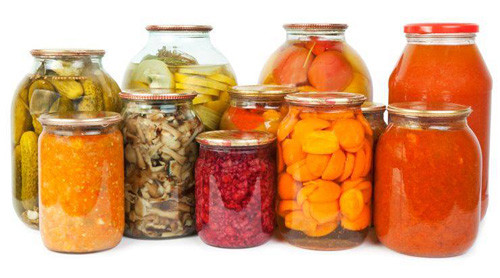
Fermented foods are those which have been processed by lactofermentation. Lactobacillus bacteria, produces lactic acid as a by-product. This explains why lacto-fermented foods taste slightly acidic. Essentially what happens is that natural bacteria feed on the sugar and starch in the food; creating lactic acid. It is an ancient form of preservation, used across many cultures throughout the world for centuries. The process also creates additional enzymes, b-vitamins, Omega-3 fatty acids, and various beneficial probiotics.
When foods begin to decompose, they naturally ferment. The enzymes created enable the food to break the food down to a more digestible form, as natural fermentation occurs. Coupled with the profusion of probiotics created during fermentation helps explain how eating fermented foods can actually aid a better digestion.
From Japanese natto, to German sauerkraut, and Korean kimichi to Bulgarian kefir, many cultures from all corners of the the world have been eating fermented foods for years. Due to their creation of friendly bacteria, these fermented foods create probiotic balance in our systems. However, these days we have additives and refrigerators which basically annulled the need for fermented foods; meaning many miss out on their health benefits.
Contents
Processed food?
Fermented foods at first seem something of an acquired taste, but after eating them a few times you do get used to them. However, it is important that you’re aware of the vital difference between natural and healthy fermented foods, and the commercially processed ones. We often mention on the site the importance of eating unprocessed food, so it may seem a bit confusing that we are suddenly extolling the virtues of this processed food. However, since this technique has been around for years in order to preserve foods naturally, it has a number of health benefits.
What are the health benefits of consuming a fermented diet?
Several health benefits can be enjoyed from consuming a diet enriched with naturally fermented foods. Primarily these concern the digestive system and are listed below:
Important nutrients
Fermented foods can be exceptional sources of vital nutrients, such as vitamin K2. A rare vitamin this helps prevent arterial plaque from building up, as well as warding off heart disease. Cheese curd, such as Icelandic Skyir or Bulgarian kefir is a fantastic source of both probiotics and vitamin K2. Natto is a Japanese fermented soya bean substance that has a gelatinous consistency. Consumed daily as a breakfast item in Japan, just a small serving of 15g provides all the K2 your system needs. Additionally, fermented food is prolific in producing many B vitamins, which are essential for giving energy.
Optimized immune system
Probiotics found in fermented food play a critical role in the maintenance of a healthy mucosal immune system in the digestive tract. A healthy gut is a central factor in upholding optimal health, as it aids the production of antibodies and pathogens. Developing a robust immune system protects your body from almost all ailments.
Detoxification
Fermented foods are some of the most highly effective detoxifiers out there. Friendly bacteria in many such foods are potent at cleansing the system. Seaweed, for example is capable of drawing out a variety of toxins and heavy metals that can wreak havoc on your system.
Budget friendly
Even a tiny amount of fermented food in each meal will give you high value for money. When you think of the tiny teaspoon of miso used in miso soup and compare it to the expense of a probiotic supplement or even small yoghurt bottle, you’ll see that these lactofermented lovelies actually save you dollars!
Microfloric variety
If you vary the fermented and cultured foods you eat, you’ll get more diversity in the beneficial bacteria you consume than you could expect from a supplement. So including natto at breakfast, kefir at lunch and kimchi in the evening meal, for example means you’ll have a whole host of healthy microflora looking after your gut.
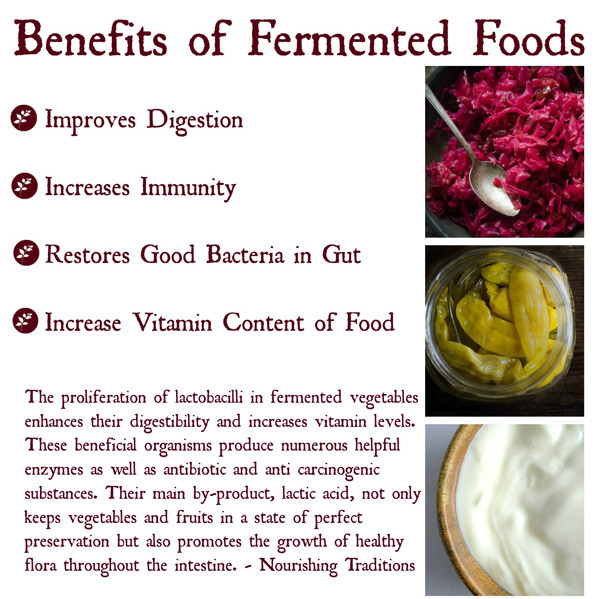
How do I prepare my own fermented foods?
Some fermented foods are really simple to prepare and can offer amazing health benefits. Why not have a go at making the following easy recipes?
Kimchi
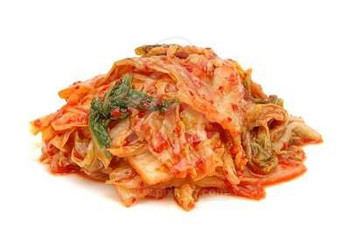
Ingredients:
- 2 heads cabbage
- 2 radishes, such as daikon, peeled and sliced
- 5 carrots, peeled and sliced
- 1 bunch scallions, sliced
- 2-inch cube piece of peeled, fresh ginger, minced
- 1 bulb (not clove bulb) garlic chopped
- 1/4 cup fish sauce
- 1/2 cup chilli paste, to taste
- 1 1/4 cups sea salt
Preparation
- First wash the cabbage leaves and leave them to soak overnight in a homemade brine of 1 cup sea salt and a gallon of cold water.
- Discard the soaking liquid and combine everything except for the salt.
- Add the remaining 1/4 cup sea salt to the mixture and mix well.
- Add the mixture a little at a time into your fermentation jar, pounding it vigorously to release the juices.
- Ensure the extracted water covers everything entirely. If it fails to, create a brine of 2 tablespoons sea salt to 4 cups water and add it to the mixture.
- Weight it down using a heavy object to press it. Cover it to ensure no vinegar flies are attracted.
- Store kimchi in a warm part of the kitchen for 5 to 7 days.
Basic sauerkraut
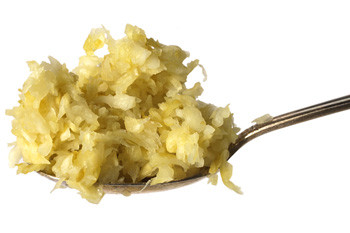
Ingredients
- 4 to 5 heads of finely shredded red or green cabbage
- 1/4 cup sea salt
Preparation
- Add the shredded cabbage a little at a time to your fermentation jar; pounding to release the juice
- An inch below the top, leave a little room for expansion. Add more cabbage if needed, and ensure that the water extracted covers the cabbage entirely. If not, create a brine of 2 tablespoons sea salt to 4 cups water and add it to the cabbage.
- Press on the vegetables and keep under brine by placing a plate or a lid on top; weighted. Again protect from flies, using a clean cloth
- Choose a warm place to allow the Sauerkraut to ferment for 7 to 10 days in the kitchen.
Simple pickled gherkins
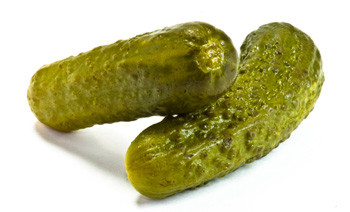
Ingredients:
- Around 24 small pickling cucumbers
- 6 cloves garlic, minced
- 6 bay leaves
- 2 ½ tbs pickling spices (cloves, cilantro, allspice, pepper, mustard seeds)
- Several handfuls fresh dill
- 6 tbs large grain sea salt
Preparation
- Sterilize your fermentation jars
- Clean and remove flower ends from cucumbers.
- To each quart sized jar, stack in as many cucumbers as you can fit.
- Divide all the spices between jars.
- Add 2 garlic cloves, and 2 bay leaves to each jar
- Add a good handful of dill to each jar, and then add more cucumbers as you can fit. Again, leave 1″ headspace between the top of the jar and the lid.
- On the stovetop, heat 1 quart of water with 6 tbs salt until it dissolves to make brine. Add 1 ⅓ cups of brine to each jar.
- Fill the remainder of the jars with sufficient water to cover ingredients.
- Place a lid on each jar and shake to mix the water and brine. Check all ingredients are submerged.
- Place jar in a cool dark place for 2 weeks, opening after one week to release air.
Here’s a short video that teaches you some easy food fermentation recipes:
The internet offers a wealth of resources for creating sourdough starters and fermented cheeses, as well as how to make miso paste, natto and other more complex recipes. Once you start to embrace this cultured way of tummy kindness, you’ll find you want more and get used to the slightly acidic taste. More importantly, your gut and immune system will thank you.
